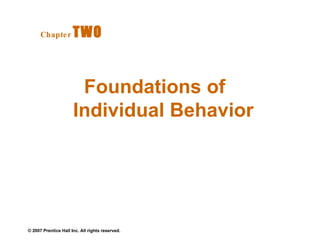Empfohlen
Power & Politics - Sources of Individual Power, Sources of Functional & Divis...

Power & Politics - Sources of Individual Power, Sources of Functional & Divis...Al - Qurmoshi Institute of Business Management, Hyderabad
Weitere ähnliche Inhalte
Was ist angesagt?
Power & Politics - Sources of Individual Power, Sources of Functional & Divis...

Power & Politics - Sources of Individual Power, Sources of Functional & Divis...Al - Qurmoshi Institute of Business Management, Hyderabad
Was ist angesagt? (20)
Organizational Behaviour Stephen Robbins 14Ed. Chapter 6

Organizational Behaviour Stephen Robbins 14Ed. Chapter 6
Power & Politics - Sources of Individual Power, Sources of Functional & Divis...

Power & Politics - Sources of Individual Power, Sources of Functional & Divis...
Introduction to Human Resource Management - HRM Dessler 12e Chapter 01

Introduction to Human Resource Management - HRM Dessler 12e Chapter 01
Andere mochten auch
Ähnlich wie Ch2
Ähnlich wie Ch2 (20)
Preparing Behavioral ObjectivesChapter 3Do Now Activity.docx

Preparing Behavioral ObjectivesChapter 3Do Now Activity.docx
Ch2
- 1. Foundations of Individual Behavior Chapter TWO
- 2. Ability, Intellect, and Intelligence Ability An individual’s capacity to perform the various tasks in a job. Intellectual Ability The capacity to do mental activities. Multiple Intelligences Intelligence contains four subparts: cognitive, social, emotional, and cultural.
- 4. Physical Abilities Physical Abilities The capacity to do tasks demanding stamina, dexterity, strength, and similar characteristics.
- 6. The Ability- Job Fit Ability-Job Fit Employee’s Abilities Job’s Ability Requirements
- 7. Biographical Characteristics Biographical Characteristics Personal characteristics —such as age, gender, race and tenure—that are objective and easily obtained from personnel records.
- 10. E X H I B I T 2 –3 Source: The Far Side ® by Gary Larson © 1993 Far Works, Inc. All rights reserved. Used with permission.
- 15. Schedules of Reinforcement Continuous Reinforcement A desired behavior is reinforced each time it is demonstrated. Intermittent Reinforcement A desired behavior is reinforced often enough to make the behavior worth repeating but not every time it is demonstrated.
- 16. Schedules of Reinforcement (cont’d) Fixed-Interval Schedule Rewards are spaced at uniform time intervals. Variable-Interval Schedule Rewards are initiated after a fixed or constant number of responses.
- 17. Schedules of Reinforcement (cont’d) E X H I B I T 2 –4 Fixed-ratio
- 18. Intermittent Schedules of Reinforcement E X H I B I T 2 –5
- 19. Intermittent Schedules of Reinforcement (cont’d) E X H I B I T 2 –5 (cont’d)

